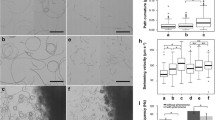Abstract
Egg extracts from 32 species of marine hydromedusae, siphonophores and sessile hydroids were tested for sperm attracting activity using the sperm of all species in both homo- and heterospecific combinations. Species-specific sperm chemotaxis could be demonstrated in nearly every species tested. Of the 1,024 possible combinations, 272 could not be attempted for lack of material. Of the 752 which were carried out, only 13 heterospecific cross-reactions were found. The bulk of these involved reactions which were either weaker in the heterospecific direction or unidirectional. The sperm behavior in response to both homospecific and heterospecific egg extracts is described. In the latter case, no changes in sperm motility or direction of movement were observed. In the former case, the sperm show turning behavior which brings them closer to the source of the extract. Since most of the Hydrozoa tested share the same habitat and are reproductively active at the same time of year, it appears that species-specific sperm chemotaxis may be a significant mechanism for both ensuring fertilization in an environment which subjects the gametes to massive dilution and preventing hybridization.
Similar content being viewed by others
Literature Cited
Ballard, W.: The mechanism for synchronous spawning in Hydractinia and Fennaria. Biol. Bull. mar. biol. Lab., Woods Hole 82, 329–339 (1942)
Cornelius, P.F.S.: The hydroid species of Obelia (Coelenterata, Hydrozoa: Campanulariidae), with notes on the medusa stage. Bull. Br. Mus. nat. Hist. (Zool.) 28, 251–293 (1975)
Dan, J.: Fertilization in the medusan, Spirocodon saltatrix. Biol. Bull. mar. biol. Lab., Woods Hole 99, 412–415 (1950)
— Acrosome reaction and lysins. In: Fertilization, Vol. 1. pp 237–293. Ed. by C.B. Metz and A. Monroy. New York: Academic Press 1967
Edwards, C.: Contributory thoughts on form, function, habitat and classification of hydroids and hydromedusae. Publs Seto. mar. biol. Lab. 20, 11–22 (1973)
— The hydroids and medusae Sarsia occulta sp. nov., Sarsia tubulosa and Sarsia loveni. J. mar. biol. Ass. U.K. 58, 291–311 (1978)
Epel, D.: The program and mechanisms of fertilization in the echinoderm egg. Am. Zool. 15, 507–522 (1974)
Giudice, G.: Developmental biology of the sea urchin embryo, 469 pp. New York: Academic Press 1973
Gray, J.: The movement of sea urchin spermatozoa. J. exp. Biol. 32, 775–801 (1956)
Hagström, B.E.: The influence of the jelly coat in situ and in solution on cross-fertilization in sea urchins. Expl Cell Res. 11, 306–316 (1956a)
— Further studies on cross-fertilization in sea urchins. Expl Cell Res. 11, 507–510 (1956b)
Hartlaub, C.: Craspedote Medusen. Nord. Plankt. 12, 237–363 (1913)
Kozloff, E.: Keys to the marine invertebrates of Puget Sound, the San Juan Archipelago and adjacent regions, 236 pp. Seattle: University of Washington Press 1974
Kramp, P.L.: Notes on some eastern Pacific species of Phialidium Leptomedusae. Pacif. Sci. 16, 1–14 (1962)
Lambert, C.: The effect of light on the spawning of Ciona intestinalis. Biol. Bull. mar. biol. Lab., Woods Hole 132, 222–228 (1967)
Mackie, G.O. and G.V. Mackie: Systematic and biological notes on living hydromedusae from Puget Sound. Bull. natn. Mus. Can. 99, 63–84 (1963)
Miller, R.L.: Chemotaxis during fertilization in the hydroid Campanularia. J. exp. Zool. 162, 23–44 (1966)
— Sperm migration prior to fertilization in the hydroid Gonothyrea loveni. J. exp. Zool. 175, 493–504 (1970)
— Gel filtration prithe sperm attractants of some marine Hydrozoa. J. exp. Zool. 182, 281–298 (1972)
— Chemotaxis of animal sperm. In: Behaviour of microorganisms, pp 31–47. Ed. by A. Perez-Miravete. London: Plenum Press 1973
—: Chemotaxis of the spermatozoa of Ciona intestinalis. Nature, Lond. 254, 244–245 (1975)
— Some observations on sexual reproduction in Tubularia. In: Coelenterate ecology and behavior, pp 299–308. Ed. by G.O. Mackie. New York: Plenum Press 1976
— Distribution of sperm chemotaxis in the animal kingdom. In: Advances in invertebrate reproduction, Vol. 1. pp 99–119. Ed. by K.G. Adiyodi and R.G. Adiyodi. Kerala, India: Peralam-Kenoth 1977a
— Chemotaxis of the sperm of Tonicella lineata (Mollusca: Polyplacophora). J. exp. Zool. 202, 203–212 (1977b)
— Site specific sperm agglutination and the timed release of a sperm chemoattractant by the egg of the leptomedusan Orthopyxis caliculata. J. exp. Zool. 205, 385–392 (1978)
— Sperm chemotaxis in the hydromedusae. II. Some chemical properties of the sperm attractants. Mar. Biol. 53, 115–124 (1979)
Minganti, A.: Experienze sulle fertilizine nelle ascidie. Pubbl. Staz. zool. Napoli 23, 58–65 (1951)
Roosen-Runge, E.C.: On the biology of sexual reproduction of hydromedusae, genus Phialidium Leuckhart. Pacif. Sci. 16, 15–26 (1962)
— and D. Szollosi: On the biology and structure of the testis of Phialidium Leuckhart (Leptomedusae). Z. Zellforsch. 68, 597–610 (1965)
Russell, F.S.: The Medusae of the British Isles. Anthomedusae, Leptomedusae, Limnomedusae, Trachymedusae and Narcomedusae, 530 pp Cambridge, England: Cambridge University Press 1953
Strathmann, M.: Methods in developmental biology, 250 pp. Friday Harbor Laboratories, University of Washington 1974. (Copies available from: Director, Friday Harbor Laboratories, Friday Harbor, Washington 98250, USA)
Summers, R.G. and B.L. Hylander: Species-specificity of acrosome reaction and primary gamete-binding in echinoids. Expl Cell Res. 96, 63–68 (1975)
Sund, P.N.: The early development of certain Puget Sound hydromedusae, 20 pp. Project Report for Invertebrate Embryology, Friday Harbor Laboratories, University of Washington 1954. (Copies available from: Director, Friday Harbor Laboratories, Friday Harbor, Washington 98250, USA)
Szollosi, D.: Unique envelope of a jellyfish ovum: the armed egg. Science, Washington, D.C. 163, 586–587 (1969)
Tyler, A.: Properties of fertilizin and related substances of eggs and sperm of marine animals. Am. Nat. 83, 195–219 (1949)
— and C.B. Metz: Effects of fertilizin treatment of sperm and trypsin-treatment of eggs on homologous and cross-fertilization in sea urchins. Pubbl. Staz. zool. Napoli 27, 128–145 (1955)
— and B. Tyler: The gametes; some procedures and properties, and physiology of fertilization and early development. In: Physiology of Echinodermata, pp 639–743. Ed. by R.A. Boolootian. New York: John Wiley-Interscience 1966
Author information
Authors and Affiliations
Additional information
Communicated by M.R. Tripp, Newark
Rights and permissions
About this article
Cite this article
Miller, R.L. Sperm chemotaxis in the hydromedusae. I. Species-specificity and sperm behavior. Marine Biology 53, 99–113 (1979). https://doi.org/10.1007/BF00389182
Accepted:
Issue Date:
DOI: https://doi.org/10.1007/BF00389182




